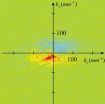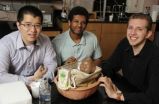(Press-News.org) BUFFALO, N.Y. – A growing body of research by multiple sclerosis (MS) investigators at the University at Buffalo and international partners is providing powerful new evidence that the brain's gray matter reflects important changes in the disease that could allow clinicians to diagnose earlier and to better monitor and predict how the disease will progress.
Over the past three years, the UB researchers and their partners around the world, supported by an active fellowship program at UB's Buffalo Neuroimaging Analysis Center (BNAC), have published journal papers and given presentations demonstrating that the thalamus region, in particular, is key to a host of issues involving MS.
"The thalamus is providing us with a new window on MS," says Robert Zivadinov, MD, PhD, UB professor of neurology, BNAC director and leader of the research team. "In our recent studies, we have used large datasets to investigate the evolution of atrophy of the thalamus and its association with clinical impairment in MS, starting with the earliest stages of the disease. The location of the thalamus in the brain, its unique function and its vulnerability to changes wrought by the disease make the thalamus a critical barometer of the damage that MS causes to the brain."
Zivadinov and UB professor of neurology Ralph Benedict discuss the new research in a video at http://youtu.be/QhsaHeBjZrA. A graphic of the thalamus and a photo of Zivadinov are at http://www.buffalo.edu/news/releases/2013/03/028.html.
At the annual meeting of the American Academy of Neurology today, Zivadinov will discuss a study he performed in collaboration with colleagues from Charles University in Prague. The study found that atrophy of the thalamus, determined with MRI, can help identify which patients with clinically isolated syndrome (CIS), a patient's first episode of MS, are at risk for developing clinically definite MS. Such a tool would be immensely helpful to clinicians, Zivadinov notes.
"This study, which included more than 200 patients, shows that thalamic atrophy is one of the most important predictors of clinically definite MS," says Dana Horakova, MD, PhD, the principal investigator at Charles University.
"Therefore, based on these findings, we think MRI should be used to determine which patients are at highest risk for a second attack," explains Zivadinov.
MS is traditionally viewed as a disease of the brain's white matter, in which myelin, the fatty material surrounding neurons that allows them to signal effectively, is gradually destroyed. The UB researchers are now revealing how the thalamus and other parts of the brain's gray matter, play a key role as well.
Central to a wide variety of neurologic functions, the thalamus is involved in motor and sensory function, the regulation of sleep and wakefulness, memory, emotion, consciousness, awareness and attention. It functions as a kind of relay center in the brain, taking in sensory information and sending it to the cerebral cortex; it also processes information coming from the cortex.
Another study, which the UB researchers conducted in collaboration with Stavanger University Hospital in Norway, is the first to look at the evolution of thalamic atrophy over a 10-year period in MS patients. Results also will be presented at the AAN meeting.
This study of 81 patients found that atrophy in the cortex and subcortical deep grey matter, including the thalamus, was significantly related to patients' declining cognitive abilities. "We found that cognitive dysfunction appears early in the course of MS and that thalamic atrophy plays a central role in predicting cognitive deterioration over the long-term," says Zivadinov.
In a review paper published earlier this year in Neurology, Zivadinov and co-authors note that gray matter injury can not only be detected in the disease's earliest stages but that this injury is associated with a wide range of symptoms from cognitive decline and motor deficits to fatigue and chronic pain.
The UB findings reveal that atrophy of the thalamus, determined through routine magnetic resonance imaging (MRI), can be an important tool in detecting, evaluating and predicting the course of MS in children and adults; it also may become a valuable method of evaluating new MS treatments.
Loss of thalamic volume and its tissue integrity can also predict cognitive impairment in MS patients, according to a study recently published in Multiple Sclerosis Journal led by UB neurology professor Ralph Benedict in collaboration with Jeroen JG Geurts, PhD, from VU University Medical Center in Amsterdam, the Netherlands.
Research currently in press by the UB team and performed in collaboration with colleagues from Charles University in Prague also was the first prospective, longitudinal study to investigate and find associations between grey matter atrophy and physical disability progression in patients with relapsing-remitting MS, the most common and most disabling type of MS.
The five-year study, which covered 180 patients, also found that thalamic atrophy has p0tential as a way to evaluate novel therapies for MS, according to Eva Havrdova, MD, PhD, principal investigator.
"Since progressive pathology of the thalamus has been shown in all different MS disease types, including in pediatric MS patients, we must look at the thalamus as a biomarker for assessing new therapies," says Zivadinov. "Measurement of thalamic atrophy may become an ideal MRI outcome for MS clinical trials.
"Atrophy in MS patients happens in the thalamus more rapidly than in other brain structures," Zivadinov continues. "It is detectable very early in the disease and it is less affected by fluid shifts in the brain, an effect of anti-inflammatory drugs used in MS. This feature in particular, makes thalamic atrophy an ideal candidate for assessing novel therapies."
These findings, says Zivadinov, are just the beginning. "Until now, existing information about thalamic involvement in MS has stemmed mainly from neuropathologic and neuroimaging studies with a limited number of subjects that contain no clear practical implications for clinicians. The team at UB, of researchers and fellows, together with our global partners, is planning to undertake larger, longitudinal studies in order to comprehensively determine how best to apply these very promising findings."
The BNAC, part of the UB Department of Neurology, is located in the Buffalo General Medical Center on the Buffalo Niagara Medical Campus.
INFORMATION:
UB co-authors with Zivadinov on these studies are: Ralph Benedict, Bianca Weinstock-Guttman, Murali Ramanathan, Michael G. Dwyer and Niels Bergsland. Co-authors at VU University Medical Center are Jeroen JG Geurts, Hanneke E Hulst and Menno M Schoonheim; at Charles University in Prague: Dana Horakova, Eva Havrdova, Michaela Tyblova, Zdenek Seidl, Manuela Vaneckova, Jan Krasensky and Tomas Kalincik.
Other co-authors are Alireza Minagar, Louisiana State University; Michael H. Barnett, University of Sydney, Australia; Daniel Pelletier, Yale University; Mohamad Ali Sahraian, Tehran University of Medical Sciences; Istvan Pirko, the Mayo Clinic; Elliott Frohman, UT Southwestern Medical Center; Cecilie Jacobsen, Turi O Dalaker, Elisabeth Farbu, Jan Petter Larsen and Kirsten Lode of Stavanger University Hospital; and Kjell-Morten Myhr and Harald Nyland, Haukeland University Hospital.
Multiple sclerosis research: The thalamus moves into the spotlight
Atrophy of the thalamus is an important predictor of clinically definite MS, study shows
2013-03-22
ELSE PRESS RELEASES FROM THIS DATE:
Berkeley Lab researchers use metamaterials to observe giant photonic spin hall effect
2013-03-22
Researchers with the U.S. Department of Energy (DOE)'s Lawrence Berkeley National Laboratory (Berkeley Lab) have once again demonstrated the incredible capabilities of metamaterials – artificial nanoconstructs whose optical properties arise from their physical structure rather than their chemical composition. Engineering a unique two-dimensional sheet of gold nanoantennas, the researchers were able to obtain the strongest signal yet of the photonic spin Hall effect, an optical phenomenon of quantum mechanics that could play a prominent role in the future of computing.
"With ...
Program improves Ph.D. student diversity
2013-03-22
PROVIDENCE, R.I. [Brown University] — A new paper in the peer-reviewed journal CBE—Life Sciences Education describes a Brown University program that has significantly improved recruiting and performance of underrepresented minority students in its nine life sciences doctoral programs over the last four years.
Data in the paper show increases in applications, admissions, enrollments, test scores, grades and scientific publications and presentations among underrepresented minority students after implementation of the program called the Initiative to Maximize Student Development ...
New method developed to expand blood stem cells for bone marrow transplant
2013-03-22
NEW YORK (March 21, 2013) -- More than 50,000 stem cell transplants are performed each year worldwide. A research team led by Weill Cornell Medical College investigators may have solved a major issue of expanding adult hematopoietic stem cells (HSCs) outside the human body for clinical use in bone marrow transplantation -- a critical step towards producing a large supply of blood stem cells needed to restore a healthy blood system.
In the journal Blood, Weill Cornell researchers and collaborators from Memorial-Sloan Kettering Cancer Center describe how they engineered ...
Pain reliever shows anti-viral activity against flu
2013-03-22
The over-the-counter anti-inflammatory drug naproxen may also exhibit antiviral activity against influenza A virus, according to a team of French scientists. The finding, the result of a structure-based investigation, is published online ahead of print in the journal Antimicrobial Agents and Chemotherapy.
New influenza vaccines must be developed annually, because the surface proteins they target mutate rapidly, the way cars used to get a whole new look every year. The researchers, led by Anny Slama-Schwok of the Institut National de la Recherche Agronomique, Jouy en ...
Scientists create new tools for battling secondhand smoke
2013-03-22
Dartmouth researchers have taken an important step in the ongoing battle against secondhand tobacco smoke. They have pioneered the development of a breakthrough device that can immediately detect the presence of secondhand smoke and even third-hand smoke.
Smaller and lighter than a cellphone and about the size of a Matchbox car, the device uses polymer films to collect and measure nicotine in the air. A sensor chip then records the data on an SD memory card. The technology is described in a new study appearing in the journal Nicotine and Tobacco Research.
"We have ...
Study offers new way to discover HIV vaccine targets
2013-03-22
Decades of research and three large-scale clinical trials have so far failed to yield an effective HIV vaccine, in large part because the virus evolves so rapidly that it can evade any vaccine-induced immune response.
Researchers from the Ragon Institute of MGH, MIT and Harvard University have now developed a new approach to vaccine design that may allow them to cut off those evolutionary escape routes. The researchers have developed and experimentally validated a computational method that can analyze viral protein sequences to determine how well different viral strains ...
Banning food ads targeted at kids
2013-03-22
Researchers from the University of Alberta are leading a charge among Canada's obesity experts and calling on the federal government to ban food and beverage ads that target children.
Kim Raine, a professor with the Centre for Health Promotion Studies in the School of Public Health at the U of A, says governments need to take action to stem the rising obesity epidemic. The only exception to a proposed food and beverage marketing ban would be for approved public health campaigns that promote healthy eating.
"Restricting marketing is not going to be a cure for childhood ...
Enzymes allow DNA to swap information with exotic molecules
2013-03-22
The discovery of the Rosetta Stone resolved a longstanding puzzle, permitting the translation of Egyptian hieroglyphs into Ancient Greek.
John Chaput, a researcher at Arizona State University's Biodesign Institute has been hunting for a biological Rosetta Stone—an enzyme allowing DNA's 4-letter language to be written into a simpler (and potentially more ancient) molecule that may have existed as a genetic pathway to DNA and RNA in the prebiotic world.
Research results, which recently appeared in the Journal of the American Chemical Society, demonstrate that DNA sequences ...
Breakthrough could lead to cheaper, more sustainable chemical production
2013-03-22
PROVIDENCE, R.I. [Brown University] — A key advance, newly reported by chemists from Brown and Yale Universities, could lead to a cheaper and more sustainable way to make acrylate, an important commodity chemical used to make materials from polyester fabrics to diapers.
Chemical companies churn out billions of tons of acrylate each year, usually by heating propylene, a compound derived from crude oil. "What we're interested in is enhancing both the economics and the sustainability of how acrylate is made," said Wesley Bernskoetter, assistant professor of chemistry at ...
Low-cost 'cooling cure' would avert brain damage in oxygen-starved babies
2013-03-22
When babies are deprived of oxygen before birth, brain damage and disorders such as cerebral palsy can occur. Extended cooling can prevent brain injuries, but this treatment is not always available in developing nations where advanced medical care is scarce. To address this need, Johns Hopkins undergraduates have devised a low-tech $40 unit to provide protective cooling in the absence of modern hospital equipment that can cost $12,000.
The device, called the Cooling Cure, aims to lower a newborn's temperature by about 6 degrees F for three days, a treatment that has been ...
LAST 30 PRESS RELEASES:
University of Oklahoma researcher awarded funding to pursue AI-powered material design
Exploring how the visual system recovers following injury
Support for parents with infants at pediatric check-ups leads to better reading and math skills in elementary school
Kids’ behavioral health is a growing share of family health costs
Day & night: Cancer disrupts the brain’s natural rhythm
COVID-19 vaccination significantly reduces risk to pregnant women and baby
The role of vaccination in maternal and perinatal outcomes associated with COVID-19 in pregnancy
Mayo Clinic smartwatch system helps parents shorten and defuse children's severe tantrums early
Behavioral health spending spikes to 40% of all children’s health expenditures, nearly doubling in a decade
Digital cognitive behavioral treatment for generalized anxiety disorder
Expenditures for pediatric behavioral health care over time and estimated family financial burden
Air conditioning in nursing homes and mortality during extreme heat
The Alps to lose a record number of glaciers in the next decade
What makes a good proton conductor?
New science reporting guide published for journalists in Bulgaria
New international study reveals major survival gaps among children with cancer
New science reporting guide published for journalists in Turkey
Scientists develop a smarter mRNA therapy that knows which cells to target
Neuroanatomy-informed brain–machine hybrid intelligence for robust acoustic target detection
Eight SwRI hydrogen projects funded by ENERGYWERX
The Lundquist Institute and its start-up company Vitalex Biosciences Announces Strategic Advancement of Second-Generation fungal Vaccine VXV-01 through Phase 1 Trials under $40 Million Competitive Con
Fine particles in pollution are associated with early signs of autoimmune disease
Review article | Towards a Global Ground-Based Earth Observatory (GGBEO): Leveraging existing systems and networks
Penn and UMich create world’s smallest programmable, autonomous robots
Cleveland researchers launch first major study to address ‘hidden performance killer’ in athletes
To connect across politics, try saying what you oppose
Modulating key interaction prevents virus from entering cells
Project explores barriers to NHS career progression facing international medical graduates
Jeonbuk National University researchers explore the impact of different seasonings on the flavor perception of Doenjang soup
Two Keck Medicine of USC Hospitals named Leapfrog Top Teaching Hospitals
[Press-News.org] Multiple sclerosis research: The thalamus moves into the spotlightAtrophy of the thalamus is an important predictor of clinically definite MS, study shows




